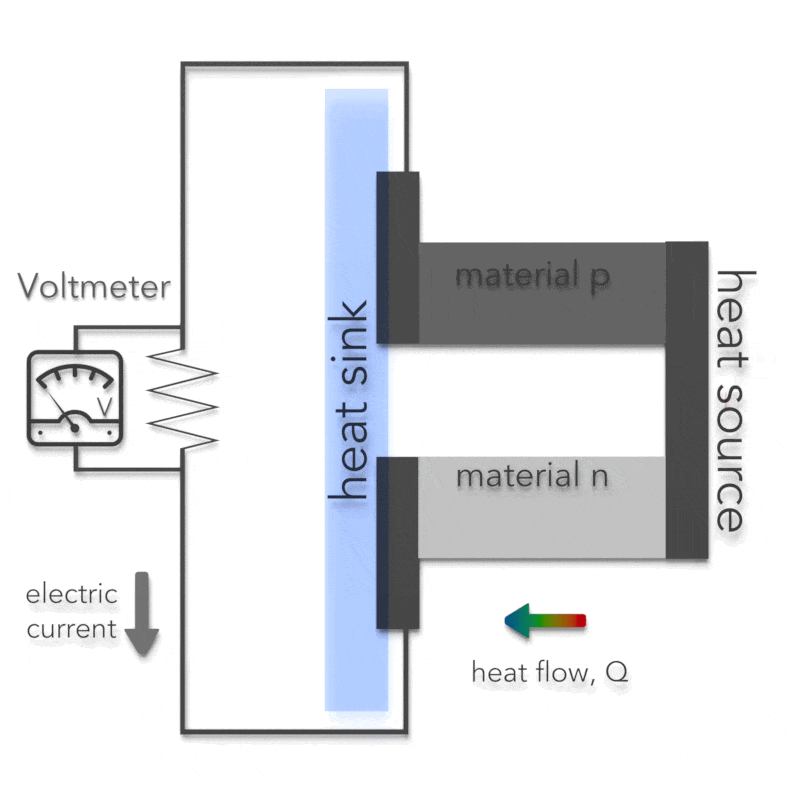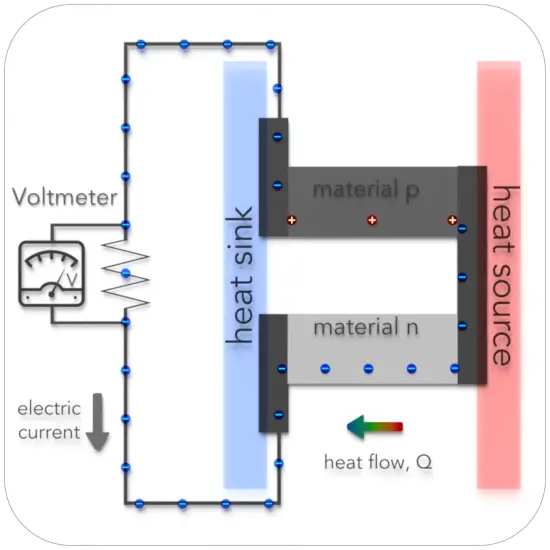30-second summary
Thermoelectricity
Thermoelectricity is generated by the thermoelectric effect, which is the direct conversion of temperature differences to electric voltage and vice versa via a thermocouple. Heating two joined dissimilar materials will cause a transfer of electrons between the materials setting up a current flow.
A thermoelectric generator (TEG), also called a Seebeck generator, is a solid state device that converts heat flux (temperature differences) directly into electrical energy through a phenomenon called the Seebeck effect.

Thermoelectricity
Thermoelectricity is generated by the thermoelectric effect, which is the direct conversion of temperature differences to electric voltage and vice versa via a thermocouple. Heating two joined dissimilar materials will cause a transfer of electrons between the materials setting up a current flow.
The term “thermoelectric effect” encompasses three separately identified effects:
- Seebeck effect. The Seebeck effect is a phenomenon in which a temperature difference between two dissimilar electrical conductors or semiconductors produces a voltage difference between the two substances. If a temperature gradient exists at a junction of two dissimilar conductors connected electrically in series and thermally in parallel, a voltage is produced. This potential drop is the result of the thermoelectric effect first reported by Thomas Seebeck in 1821. Seebeck focused primarily on the power generating properties of a thermocouple known as the Seebeck effect. The voltage generated depends on the Seebeck coefficient S (S = V/ΔT) and the temperature difference between the two junctions in the thermocouple.
- Peltier effect. The Peltier effect is the analog to the Seebeck effect. The Peltier effect is the presence of heating or cooling at an electrified junction of two different conductors and is named after French physicist Jean Charles Athanase Peltier, who discovered it in 1834. Instead of generating a potential difference across C and D with junctions J1 and J2 held at different temperatures, the Peltier effect uses an electromotive source to drive a current, heating one junction and cooling the other. The effect can be quantitatively described by the Peltier coefficient. The Peltier coefficient (π) is determined by the ratio of the current, (I) to the rate of heating (q): π = I/q. It represents how much heat is carried per unit charge. The sign of π is determined by which junction is heated and which is cooled. A typical Peltier heat pump involves multiple junctions in series, through which a current is driven. Some of the junctions lose heat due to the Peltier effect, while others gain heat. Thermoelectric heat pumps exploit this phenomenon, as do thermoelectric cooling devices found in refrigerators.
- Thomson effect. In different materials, the Seebeck coefficient is not constant in temperature, and so a spatial gradient in temperature can result in a gradient in the Seebeck coefficient. If a current is driven through this gradient, then a continuous version of the Peltier effect will occur. The Thomson effect describes the resulting electric current that develops in a single conductor when a small temperature gradient is applied. This relationship is described by the equation; q = βIΔT, where q is the rate of heating, I is an electric current, ΔT is the change in temperature, and β is the Thomson coefficient. Lord Kelvin, tied all three of the thermoelectric coefficients together in the Kelvin relationships. These equations describe how the Seebeck, Peltier, and Thomson coefficients interrelate.
The Peltier effect can be considered as the back-action counterpart to the Seebeck effect: if a simple thermoelectric circuit is closed, then the Seebeck effect will drive a current, which in turn (by the Peltier effect) will always transfer heat from the hot to the cold junction. The close relationship between Peltier and Seebeck effects can be seen in the direct connection between their coefficients:
The second Thomson relation:
Π = TS
where Π is the Peltier coefficient, T is the absolute temperature, and S is the Seebeck coefficient.
Mechanisms of Thermoelectric Effect

For example, when two dissimilar metals like copper and zinc are joined together, a transfer of electrons can take place. Electrons will leave the copper atoms and enter the zinc atoms. The zinc gets a surplus of electrons and becomes negatively charged. The copper loses electrons and takes on a positive charge. This creates a voltage potential across the junction of the two metals. The heat energy of normal room temperature is enough to make them release and gain electrons, causing a measurable voltage potential. As more heat energy is applied to the junction, more electrons are released, and the voltage potential becomes greater.
A device like this is generally referred to as a “thermocouple.”
Thermocouples are electrical devices consisting of two dissimilar electrical conductors forming an electrical junction. A thermocouple produces a temperature-dependent voltage as a result of the thermoelectric effect, and this voltage can be interpreted to measure temperature. For example, constantan is the negative element of the type J thermocouple with iron being the positive. The type J thermocouples are used in heat treating applications. Also, Constantan is the negative element of the type T thermocouple with copper the positive. These thermocouples are used at cryogenic temperatures.
Applications of Thermoelectric Effect
The thermoelectric effect has various applications:
- Thermoelectric Generator. A thermoelectric generator (TEG), also called a Seebeck generator, is a solid state device that converts heat flux (temperature differences) directly into electrical energy through a phenomenon called the Seebeck effect. Seebeck generators are less bulky than traditional heat engines, have no moving parts, and are typically more expensive and less efficient.
- Thermoelectric cooling. Thermoelectric cooling uses the Peltier effect to create a heat flux at the junction of two different types of materials. A Peltier cooler, heater, or thermoelectric heat pump is a solid-state active heat pump that transfers heat from one side of the device to the other, with the consumption of electrical energy, depending on the direction of the current. It is compact and has no circulating fluid or moving parts. Such refrigerators are useful in applications where their advantages outweigh the disadvantage of their very low efficiency. Such an instrument is also called a Peltier device, Peltier heat pump, solid state refrigerator, or thermoelectric cooler (TEC).
- Temperature measurement. Thermocouples are electrical devices consisting of two dissimilar electrical conductors forming an electrical junction. A thermocouple produces a temperature-dependent voltage as a result of the thermoelectric effect, and this voltage can be interpreted to measure temperature.
Thermoelectric Materials
Thermoelectric materials convert thermal energy into electrical energy by a process known as thermoelectric conversion. The heat source giving rise to the temperature difference can be combustion engines, sunlight, chemical reactions, or nuclear decay.
These materials must have both high electrical conductivity (σ) and low thermal conductivity (κ) to be good thermoelectric materials. Having low thermal conductivity ensures that when one side is made hot, the other side stays cold, which helps to generate a large voltage while in a temperature gradient.
Three materials are commonly used for thermoelectric generators. For many years, the main three semiconductors known to have both low thermal conductivity and high power factor are bismuth (Bi2Te3) telluride, lead telluride (PbTe), and Silicon germanium (SiGe). Which material is used depends on the characteristics of the heat source, cold sink, and the design of the thermoelectric generator. Today, the thermal conductivity of semiconductors can be lowered without affecting their high electrical properties using nanotechnology. This can be achieved by creating nanoscale features such as particles, wires, or interfaces in bulk semiconductor materials.
Thermoelectric Generator – Seebeck Generator
A thermoelectric generator (TEG), also called a Seebeck generator, is a solid state device that converts heat flux (temperature differences) directly into electrical energy through a phenomenon called the Seebeck effect. Thermoelectric materials are utilized for power generation in remote locations, on spacecraft used for interplanetary exploration and in places where waste heat can be recovered. Thermoelectric power generation will also play a role in providing needed energy sources for developing nations in remote areas. A simple wood burning stove or open fire could become a potential cell phone charging station or even provide LED lighting in small villages. Recent uses include stove fans, lighting powered by body heat and a smartwatch powered by body heat.
While traditional thermoelectric devices have offered good reliability, durability, and little performance degradation over time, more comprehensive usage has been restricted by very low system efficiency and power-specific cost ($/W) of existing devices. For instance, estimates that using the common thermoelectric materials available at present, efficiency is limited to perhaps 1/6th of the maximum possible Carnot efficiency.

